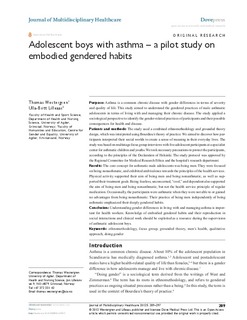| dc.contributor.author | Westergren, Thomas | |
| dc.contributor.author | Lilleaas, Ulla-Brit | |
| dc.date.accessioned | 2012-11-09T13:04:45Z | |
| dc.date.available | 2012-11-09T13:04:45Z | |
| dc.date.issued | 2012 | |
| dc.identifier.citation | estergren, T., & Lilleaas, U.-B. (2012). Adolescent boys with asthma : a pilot study on embodied gendered habits. Journal of Multidisciplinary Healthcare, 12(5), 289-297. doi: 10.2147/jmdh.s37517 | no_NO |
| dc.identifier.issn | 1178-2390 | |
| dc.identifier.uri | http://hdl.handle.net/11250/138696 | |
| dc.description | Publkished version of an article from the journal: Journal of Multidisciplinary Healthcare. Also available from Dove Press:http://dx.doi.org/10.2147/jmdh.s37517 | no_NO |
| dc.description.abstract | Purpose: Asthma is a common chronic disease with gender differences in terms of severity and quality of life. This study aimed to understand the gendered practices of male asthmatic adolescents in terms of living with and managing their chronic disease. The study applied a sociological perspective to identify the gender-related practices of participants and their possible consequences for health and disease.
Patients and methods: The study used a combined ethnomethodology and grounded theory design, which was interpreted using Bourdieu’s theory of practice. We aimed to discover how participants interpreted their social worlds to create a sense of meaning in their everyday lives. The study was based on multistage focus group interviews with five adolescent participants at a specialist center for asthmatic children and youths. We took necessary precautions to protect the participants, according to the principles of the Declaration of Helsinki. The study protocol was approved by the Regional Committee for Medical Research Ethics and the hospital’s research department.
Results: The core concept for asthmatic male adolescents was being men. They were focused on being nonasthmatic, and exhibited ambivalence towards the principles of the health services. Physical activity supported their aim of being men and being nonasthmatic, as well as supported their treatment goals. Being fearless, unconcerned, “cool,” and dependent also supported the aim of being men and being nonasthmatic, but not the health service principle of regular medication. Occasionally, the participants were asthmatic when they were not able to or gained no advantages from being nonasthmatic. Their practice of being men independently of being asthmatic emphasized their deeply gendered habits.
Conclusion: Understanding gender differences in living with and managing asthma is important for health workers. Knowledge of embodied gendered habits and their reproduction in social interactions and clinical work should be exploited as a resource during the supervision of asthmatic adolescent boys.
Keywords: ethnomethodology, focus group, grounded theory, men’s health, qualitative approach, doing gender | no_NO |
| dc.language.iso | eng | no_NO |
| dc.publisher | Dove Press | no_NO |
| dc.title | Adolescent boys with asthma : a pilot study on embodied gendered habits | no_NO |
| dc.type | Journal article | no_NO |
| dc.type | Peer reviewed | no_NO |
| dc.subject.nsi | VDP::Medical disciplines: 700::Health sciences: 800 | no_NO |
| dc.source.pagenumber | 289-297 | no_NO |
| dc.source.volume | 12 | no_NO |
| dc.source.journal | Journal of Multidisciplinary Healthcare | no_NO |
| dc.source.issue | 5 | no_NO |
